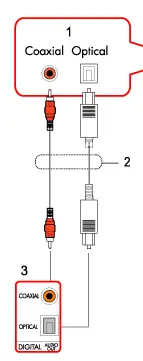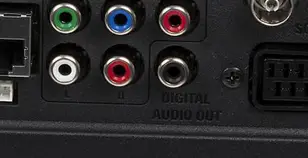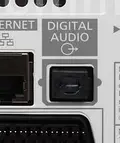SPDIF out port
S/PDIF is Sony/Philips Digital Interconnect Format, sometimes decoded as Sony Philips Digital Interface (same acronym). This format was developed by Sony and Phillips. This format can be transmitted over optical or coaxial cable. In fact, it is a data transmission protocol. That is, it is important to understand that this standard has nothing to do with the type of cable, it is the standard for encoding and subsequent transfer of data.
What is SPDIF meaning in TV?
SPDIF is a data transfer format used to connect various home theater and entertainment system components to sound systems.
It is based on the AES3 standard and transmits two channels of uncompressed PCM or compressed 5.1/7.1 surround sound (such as the DTS audio codec, for example).
However, this standard does not support lossless surround sound formats, as they require higher bandwidths.
What is the difference between Digital Audio Out SPDIF and Optical SPDIF?
There are two SPDIF standards by connector type: copper and optical. These two standards are the same in terms of encoding type. The difference is that Digital Audio Out SPDIF uses a copper cable to transmit data (audio, for example), while Optical SPDIF uses optical fiber to transmit audio.
As I said, these outputs were developed jointly by Sony and Philips to use in TVs and other audio devices. And they’re primarily used to transmit audio, for example, from a TV to an external active speaker (such as a soundbar).
Initially, SPDIF supported audio transmission in stereo format, without compression. After further refinement, SPDIF supports the output of sound in 5.1, 7.1, and compressed formats.
The brief history of SPDIF out
Originally, this transfer format emerged in the 1990s, at the beginning of the digital audio era, when audio began to be recorded digitally on CDs.
It was then that the need arose to transmit audio digitally to a soundbar or speaker without additional conversions. That’s when SPDIF was developed, which was designed to transmit audio from the DVD player to speakers, stereo systems, and soundbars.
SPDIF did the job completely, so over time, it became very common in the industry. SPDIF is used in TVs, in the form of an optical output. Later were introduced similar audio transmission options such as HDMI ARC.
What is the difference between SPDIF and Optical?
In addition to SPDIF, there is another audio transmission format that is actively used – Toslink (also known as Optical). It is a format for transmitting signals using fiber optics.
To briefly go into how it works from a technical point of view, fiber optic cables transmit information in the form of light, which passes through an optical fiber.
When we say “Optical,” we mean ADAT format, which is sort of a competitor to SPDIF. However, such a signal has to be converted to fight interference. But there are advantages as well. Unlike data transmission over copper cables, light does not suffer from attenuation or impedance, so the signal can be transmitted over any distance.
Optical signal is usually sent through a fiber optic cable, while SPDIF is usually used with a coaxial cable with an RCA connector. However, Optical SPDIF via optical cable can also be used.
What is Digital Audio Out SPDIF?
Digital Audio Out is the output is in the form of the familiar plug since the days of analog television, the correct name is RCA. The devices are connected to each other with a coaxial cable, the sound is transmitted digitally using special protocols. The approximate maximum cable length between the devices is 10 meters (32 feet). But the maximum cable length depends on the quality of the materials used and the manufacture of the cable.
What is Optical SPDIF?
Optical SPDIF (Sony/Philips Digital Interface Format) is the standard to transmit signals via the optical cable. The sound is transmitted using a laser over an optical cable between the devices. The power of the transmitted optical signal is enough to transmit the signal to the distance between the devices about 10 meters. In the case of optical cable, the connector on the device is called Toslink.
Optical SPDIF vs Digital Audio Out SPDIF
These outputs are the same in terms of the quality of the transmitted signal. However, in the case of Optical SPDIF, an optical signal is used as the signal transmission, in the second case a physical signal is used.
In both cases, the audio signal is transmitted digitally and is not subject to distortion or attenuation. Unlike the analog signal, which is distortion-prone and fades unevenly at different frequencies: the higher the frequency the more the signal fades. Both SPDIF formats are used quite widely, optical in TVs, physical interfaces are more common in computers.
Other ports for digital audio transmission
Similar connections for the transmission of digital audio aren’t numerous, one of the main tasks of such protocols is the transmission of DTS or Dolby digital multichannel audio from one device to another.
Similar functions are performed by the HDMI port and a variant of HDMI ARC, Display Port. But these are protocols that combine video and audio transmission, SPDIF is purely an audio transmission format.







